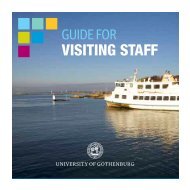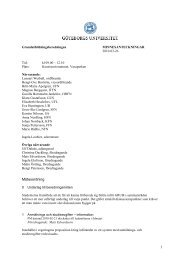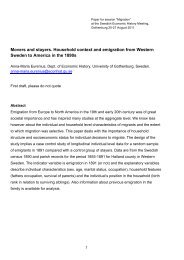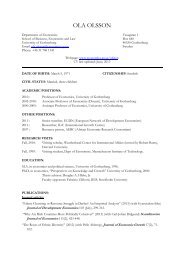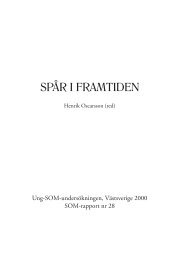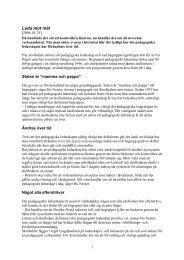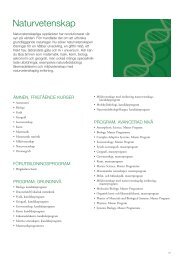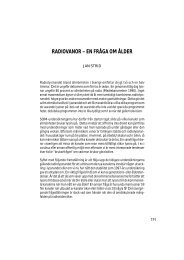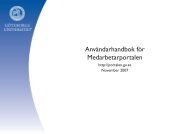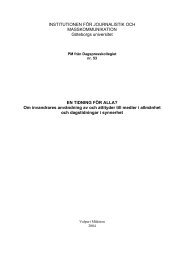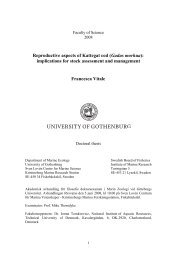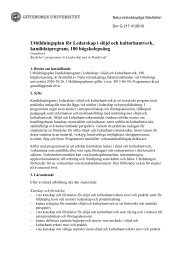The History of - Göteborgs universitet
The History of - Göteborgs universitet
The History of - Göteborgs universitet
Create successful ePaper yourself
Turn your PDF publications into a flip-book with our unique Google optimized e-Paper software.
1971 the School <strong>of</strong> Business, Economics and Law becomes part<br />
<strong>of</strong> the University.<br />
1977 a new higher education reform enables the incorporation <strong>of</strong> a large<br />
number <strong>of</strong> independent educational institutions into the University, for example<br />
the university colleges for public administration, teacher education, journalism,<br />
music and performing arts.<br />
Social Sciences<br />
<strong>The</strong> social sciences did not form their own faculty<br />
until 1964. At that point the different subjects were<br />
scattered across the city and were <strong>of</strong>ten housed in <strong>of</strong>fice<br />
facilities or even apartment buildings, yet there<br />
was a widespread interest in joint coordination.<br />
In 1990 a large share <strong>of</strong> the Faculty <strong>of</strong> Social Sciences<br />
moved into new buildings along Sprängkullsgatan.<br />
<strong>The</strong> parts <strong>of</strong> the Faculty that moved into the new<br />
facilities included the Department <strong>of</strong> Social Work<br />
and the School <strong>of</strong> Public Administration.<br />
<strong>The</strong>y both date back to 1944, when the first group<br />
<strong>of</strong> students met at Gothenburg’s institute for social<br />
studies, the second <strong>of</strong> its kind in Sweden.<br />
On 1 June 1963 all institutes <strong>of</strong> social studies<br />
were nationalised and renamed socialhögskolor, or<br />
schools <strong>of</strong> social studies. In 1977 the school <strong>of</strong> social<br />
studies in Gothenburg became part <strong>of</strong> the University<br />
and hence could <strong>of</strong>fer third-cycle studies.<br />
In 1979 the University <strong>of</strong> Gothenburg appointed<br />
Sweden’s first pr<strong>of</strong>essor in social work, Harald Swedner.<br />
In 1983 the school was split into two departments,<br />
the Department <strong>of</strong> Social Work and the School <strong>of</strong><br />
Public Administration.<br />
<strong>The</strong> first pr<strong>of</strong>essorship in public administration<br />
at the University <strong>of</strong> Gothenburg was established already<br />
in 1901.<br />
<strong>The</strong> research at the School has long had a particular<br />
focus on studies <strong>of</strong> voters and elections. Interview surveys<br />
have been conducted regularly since the 1950s.<br />
<strong>The</strong> SOM Institute serves as a centre for the survey<br />
and seminar work carried out jointly by the Department<br />
<strong>of</strong> Journalism, Media and Communication, the<br />
School <strong>of</strong> Public Administration and the Centre for<br />
Public Sector Research (CEFOS) at the University <strong>of</strong><br />
Gothenburg. <strong>The</strong> work is centred around the national<br />
survey that covers 9 000 individuals aged 16-85.<br />
<strong>The</strong> survey addresses issues such as politics, society,<br />
media habits, public service, the environment, risks,<br />
new media technology and leisure.<br />
Completed in 2007, Campus Linné is the University’s<br />
newest area. It consists <strong>of</strong> two old, renovated<br />
buildings deeply rooted in the history <strong>of</strong> Gothenburg,<br />
as well as a new building. Gothenburg’s old<br />
teachers’ college building <strong>of</strong>fers mainly lecture halls,<br />
group activity rooms and a cafeteria. Many people in<br />
Gothenburg were born in the city’s old maternity<br />
ward, built in 1924. Today the building is home to the<br />
Department <strong>of</strong> Global Studies.<br />
<strong>The</strong> brand new building is occupied by the<br />
Depart ment <strong>of</strong> Journalism, Media and Communication<br />
(JMG), formed in 1990. <strong>The</strong> University started<br />
<strong>of</strong>fering programmes in media and communication<br />
studies in the same year.<br />
<strong>The</strong> red brick building located closer to Linnéplatsen<br />
is called Psykologen, or ‘the Psychologist’, and<br />
is home to the University’s research and education in<br />
the field <strong>of</strong> psychology.<br />
22 <strong>The</strong> <strong>History</strong> <strong>of</strong> the University <strong>of</strong> Gothenburg



